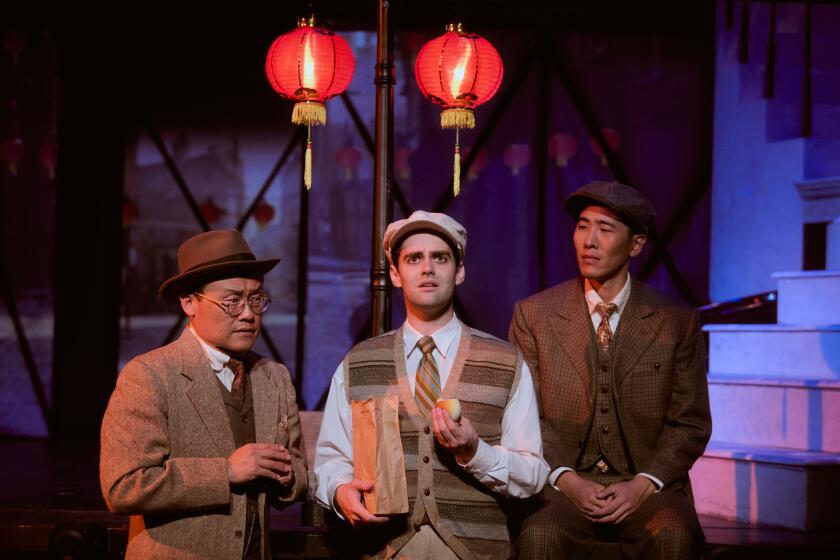Art, politics and amends in Venice
Given the low esteem in which the United States is widely held around the world these days, it is ironic that an American curator has for the first time organized the globe’s longest-running international art exhibition, the 112-year-old Venice Biennale. As if issuing something between a challenge and a demand, the event seems to declare, “Acquit yourself on the world’s cultural stage.”
For the most part, this show does.
Robert Storr, a painter and dean of the Yale University School of Art, organized the 52nd Biennale, which consists of three primary components. Recalling the extravaganza’s origins in 19th century world’s fairs are the national pavilions -- 57 this year, clustered at the main exhibition site in or near the Public Gardens and scattered in temporary locations all over the enchanting island city. (Each home country selects one or more artists to represent it.) Italy’s host pavilion and the sprawling Arsenale -- a defunct Venetian rope factory -- are the sites for a two-part international survey assembled by Storr.
The curator apparently drew on personal history for the shows, which dote on painting and politics. (When Storr started to paint more than 30 years ago, he went to Mexico City and became a studio assistant on the final, failed mural by revolutionary firebrand David Alfaro Siqueiros.) The 2005 Biennale had liberty, personal and public, as its loose theme. This one is pungent with a sense of loss.
The show is dubbed “Think With the Senses, Feel With the Mind: Art in the Present Tense,” and it’s that last part that resonates. The present is tense indeed. The show’s abundance of strong painting suggests a profound social value is found in its characteristically slow deliberations.
Art’s elusive power
The exhibition, continuing through Nov. 21, is committed to established, major painters in Germany and the U.S., most notably Sigmar Polke, Gerhard Richter, Martin Kippenberger, Ellsworth Kelly, Robert Ryman and Susan Rothenberg. It also includes more modest, lesser-known but certainly gifted ones, such as the American Thomas Nozkowski, Colombian Oscar Munoz (at the Arsenale) and Congolese Cheri Samba. The impressive array spans Polke’s alchemical transformation of matter into image and Munoz’s relentlessly disappearing portraits of men and women, painted with water on cement and videotaped as they evaporate.
The show’s entrance is pointed in its politics but no less indirect in its aesthetic allusiveness. Across the Italian Pavilion’s fascist-era facade, Conceptual artist Lawrence Weiner prints a blue and orange arc of words: “Matter so shaken to its core to lead to a change in inherent form.” The legend is meaningful as a scientific description of its rainbow shape, an insinuation of topical events such as 9/11 or Iraq’s occupation and -- not least -- a poetic account of art’s elusive power.
Inside the front door, Nancy Spero’s “Maypole/Take No Prisoners” dangles ribbons and severed profile-heads in painted metal on chains from a tall steel pole rising into the skylight. (Welcome to the show!) The maypole is an ancient pagan form, part playful axis linking earth and sky and part communal symbol of authority. Spero’s grim yet marvelous version greets summer with the clanging of bloody, spewing faces, blown by the breeze and festooned with tassels.
The pavilion is heavily weighted with internationally celebrated stars -- Sophie Calle, Bruce Nauman, Jenny Holzer, Giovanni Anselmo and the late Sol Lewitt included. Lewitt’s opposing pair of exquisite wall drawings, one a gathering cloud of black scribbles, the other a luminous glow emerging from scribbled darkness, are flatly magnificent. Nauman’s abject recirculating fountains, made from inside-out wax portrait masks spitting water into industrial sinks over plastic buckets, was unfortunately on the fritz the day I visited. The others, such as Holzer’s declassified U.S. torture documents silk-screened onto acid green panels, tend toward grandiloquence.
Two younger, little-known artists make big impressions. Both offer laments for modern life, set in cinematic landscapes.
Joshua Mosley, 32, employs digitally sophisticated “claymation” for a melancholic meditation on human alienation from nature, starring 18th century philosophers Rousseau and Pascal. The evanescence of their forest encounters with a giant beetle, an obtuse cow and a romping dog, projected in a six-minute black-and-white film, is contrasted with plain-spoken bronze sculptures of all the magically animated figures, reducing them to lovely, obsolete trinkets. The philosophical dilemma between mind and matter is beautifully conjured.
Mario Garcia Torres, 31, born in Mexico and working in Los Angeles (where to my knowledge he has not shown), presents a terrific Super 8 film transferred to video. The shift from an industrial to an electronic medium is telling. His work pits old Modernist-era dreams against today’s realities.
The grainy film pans the Barranca de Oblatos, a 2,000-foot canyon outside Guadalajara, while subtitles record a putative letter to that city’s Dr. Atl -- Gerald Murillo, the father of Mexican Modernism. Dr. Atl’s devotion to landscape painting often merged with his interest in volcanoes, fusing metaphors for powerful forces of nature and culture. The letter, meanwhile, is a witty, sometimes lacerating inquiry into the Guggenheim Museum’s now-stalled plan to build a cultural tourist destination at the canyon’s awesome edge.
Over at the Arsenale, things are more erratic. Its entrance houses Italian artist Luca Buvoli’s shattered installation, “A Very Beautiful Day After Tomorrow,” which graphically leafs through the century-old implications of Futurist art and its aesthetic glorification of war. By now, that ironic riff is pretty tired.
At the other end of the quarter-mile-long hall, an enormous tapestry, woven like an industrial-strength kente cloth from scavenged bottle caps, metal tags and packaging materials by the Ghanaian El Anatsui, is raised up like a magnificent banner. It attests to the transformative power of imagination, without any ironic exhaustion. (Incidentally, a fine survey of El Anatsui’s work is at UCLA’s Fowler Museum through Aug. 26.)
Between these two poles, not much is going on.
There are lots of photographs showing a litany of tragic events: Australian prisons, hospital triage mannequins, Moroccan tourist-development sites, urban guard shacks, urban slums, cemetery headstones, etc. Few are more than ordinary. When Japanese artist Hiroharu Mori raises a helium-filled “thought balloon” wittily festooned with a camouflage question-mark high into the nearby rafters, he unexpectedly speaks for me: So what else is new?
Perhaps the strongest works are two large installations. An immense, room-size chandelier of glitzy neon and bric-a-brac by the late L.A. artist Jason Rhoades collides Tijuana and Tangier in a global orgy of ramshackle erotica. And Belgian expatriate to Mexico Francis Alys deftly juxtaposes the repetitive task of drawing, mass media and mundane labor in a room stuffed with 500-plus pencil drawings. Alys used them to animate an ethereal film of a pair of hands shining a shoe, which flickers like a sweet dream in the next room.
African representation
A pan-African exhibition is also at the Arsenale. Titled “Check List-Luanda Pop,” it’s a diverse assortment of works by 30 artists, representing African residents and the diaspora (Yinka Shonibare, Marlene Dumas, Chris Ofili and others). What’s discouraging is that the show is drawn from a single Angolan private collection, not assembled by independent curatorial conviction.
Overall the national pavilions are the Biennale’s flattest, least engaging segment -- perhaps because the transnational nature of today’s art world contradicts their stubborn format. If, say, a Montreal artist goes to art school in New York and then moves to London, would his sculpture most fittingly represent Canada, the U.S. or England?
David Altmejd might know the answer, since he was born in Montreal, went to Columbia University, resides in London and has a knockout sculpture installation in the Canadian Pavilion. The raucous display of mutant flora and fauna, evoking a morbid natural history museum, is reflected in an opulent maze of crystalline mirrors. Altmejd crashes acculturated nature into decaying culture, assembling a bleak fun-house tableau. An ancient theme of human vanity is given a darkly Postmodern jolt.
Only one other on-site and one off-site pavilion are memorable. That’s not many.
Aernout Mik, representing the Netherlands, has a disorienting, multichannel video installation whose individual scenes of grim catastrophe and chaotic law enforcement are part documentary, part staged. Often it’s not easy to tell which is which, adding a hallucinatory quality to the event.
Free-standing video screens are installed amid beige floor mattresses and metal cots, some inside a makeshift shed that protrudes from the main pavilion. This desolate environment collapses a refugee camp into a prison, simultaneously offering distant hope and no future.
In town at the gorgeous Palazzo Soranzo Van Axel, Mexico’s first pavilion features six electronic works by Rafael Lozano-Hemmer. They engage a visitor’s body to enact technological events.
In the loveliest, you grip a metal handle and see your heartbeat translated into pulsing light from a solitary hanging bulb. That light-pulse then joins 99 others suspended from the ceiling, recalling unknown people who have since left the room. When it dawns on you that the addition of your “light-beat” means that a bulb at the other end has necessarily been extinguished, the sculpture blossoms as a poignant memento mori.
Special treatment
Would that the same could be said for the U.S. Pavilion, where a mini-retrospective of Conceptual pieces, made 10 to 16 years ago by the late Felix Gonzalez-Torres (1957-1996), is a major disappointment. Many familiar works are here, including the suspended strings of interconnected light bulbs, the funereal rectangle of licorice candies spread out on the floor and the stacks of souvenir graphics -- one showing the darkening surface of the sea -- that visitors are invited to take away and that are perpetually replenished. It struggles to appear more than an earnest tribute to a famous artist, sounding exactly the wrong note.
The other frustration is the British Pavilion, where the usually brash Tracey Emin lines the walls with a sizable array of small, intense, diary-like drawings, reminiscent of Egon Schiele. Feeble groups of Expressionist paintings, sculptures made from sticks screwed together to form rickety towers and pale-pink neon diary scrawls complete the wan ensemble.
Emin is notorious for putting typically private intimacies on pointedly ostentatious public display. But these lovely, delicate drawings, many of sexual subjects, get pretty well squashed in the pavilion’s baronial context.
christopher.knight@latimes.com
More to Read
The biggest entertainment stories
Get our big stories about Hollywood, film, television, music, arts, culture and more right in your inbox as soon as they publish.
You may occasionally receive promotional content from the Los Angeles Times.







